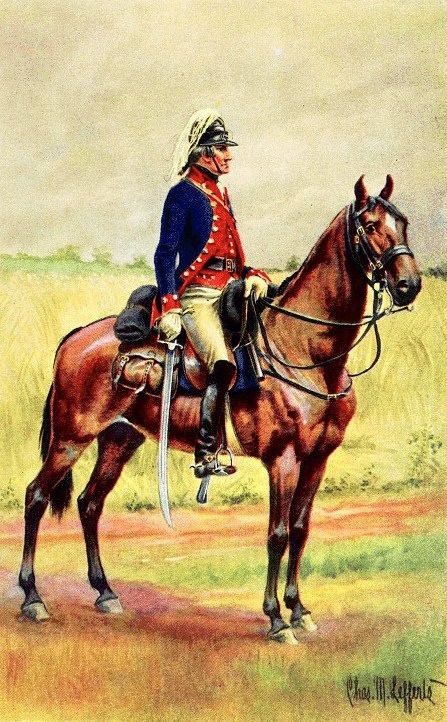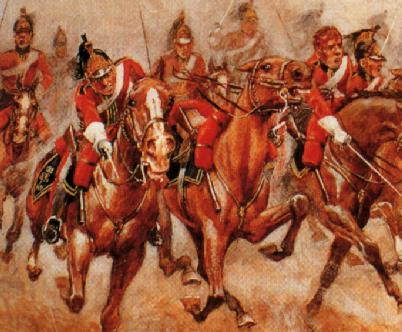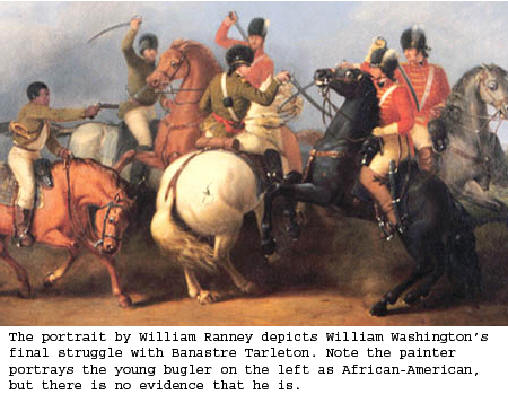
The Battle of Cowpens

 |
The Battle of Cowpens |
 |
On January 17, 1781, the British army invading the colonies experienced a rout that would prove to be a watershed moment in the Revolutionary War.
General Daniel Morgan, commanding a small army of about nineteen hundred men, stationed his troops in a place known to the local South Carolinians as "cowpens" because it was a perfect natural pasture fenced in by forest to the north, west, and south and the Broad River to the east. The field, which was about 400 yards wide, contained a few trees scattered randomly and two hills near the eastern end, the higher of the two nearer to the Broad River, but was pretty much empty. His army contained one thousand militia, commanded by Andrew Pickens, 300 autonomous riflemen sharpshooters, about 120 cavalry, commanded by William Washington, and 500 continental soldiers commanded by John Howard. Morgan positioned his riflemen at the west end of the field, about 350 yards west from the small hill. One hundred fifty yards east lay the militia in a line. One the small hill, the continental soldiers stood and concealed behind the large hill William Washington's cavalry was poised, ready to strike.
The enemy commander was Lieutenant Colonel Banastre Tarleton. Tarleton was the scourge of the south, completely slaughtering everything and everyone in his path. The British twenty-six year old was famous for the massacre of the Third Virginia Continentals traveling through the Waxhaw area after the fall of Charleston. He refused their surrender after they killed his horse in battle. This refusal of offering no quarter is the beginnings of the term "Tarleton's quarter." Tarleton had a force of about 1000 British dragoons, which are highly trained mounted special forces. He predicted a quick and decisive victory for his troops. His prediction was wrong.
Tarleton's plan was fairly simple, to charge into
the enemy position at Cowpens and kill all of the "Yankee rebels" under Morgan.
He knew the American militia would cower and run when they saw the superior
dragoons, and the American army split in two did not stand a chance. Morgan knew
this too, and used this piece of information to his advantage. He gave orders
for his line of riflemen to shoot only the British officers (identifiable by
their golden shoulder pads) and when they felt overwhelmed they should retreat
to behind the line of militia. The militia had orders to fire two shots at any
British target, and then they should retreat to the southern end of the hills
and form a wall. Since it was a long run from the militia's
 position to the
hills, Morgan ordered his cavalry to come out of their concealment and stall the
British lines, giving the riflemen and militia time to get to their destination.
Also, when the dragoons of Tarleton were in range, the 500 continental soldiers
on the small hill were to fire at them. At this time, the dragoons, seeing the
retreating armies, sensed victory, and the 71st Highlanders from Scotland came
out of reserve and charged towards the retreating militia. Morgan quickly
galloped towards the militia and ordered them to turn and fire in unison. This
volley of bullets destroyed the charging British and was the turning point in
the battle. The British valiantly fought on, but they knew they would be
defeated. Tarleton, in an effort to save himself, took a handful of his cavalry
and raced west towards the direction they came. William Washington saw the small
group retreating, recognized Tarleton, and sped off to chase them. Washington
and Tarleton fought each other, swords flailing in the air, when a British
mounted soldier held his sword up, ready to strike. A young bugler (supposedly
African American with the last name of Ball, Collins, or Collin) saw this
soldier, raised his pistol, and shot Washington's attacker, saving Washington's
life. Tarleton and the remains of his group raced off to give the sad tidings of
the battle back to General Cornwallis, while the rest of his men, surrounded by
Americans, surrendered at Cowpens. A majority of the Americans wanted to kill
them and show them "Tarleton's quarter" like they had done to the Americans at
Waxhaw, but Morgan ordered them to not kill them, to leave them unharmed, for he
felt that the Americans should set the example for the British and should not
descend to Tarleton's level.
position to the
hills, Morgan ordered his cavalry to come out of their concealment and stall the
British lines, giving the riflemen and militia time to get to their destination.
Also, when the dragoons of Tarleton were in range, the 500 continental soldiers
on the small hill were to fire at them. At this time, the dragoons, seeing the
retreating armies, sensed victory, and the 71st Highlanders from Scotland came
out of reserve and charged towards the retreating militia. Morgan quickly
galloped towards the militia and ordered them to turn and fire in unison. This
volley of bullets destroyed the charging British and was the turning point in
the battle. The British valiantly fought on, but they knew they would be
defeated. Tarleton, in an effort to save himself, took a handful of his cavalry
and raced west towards the direction they came. William Washington saw the small
group retreating, recognized Tarleton, and sped off to chase them. Washington
and Tarleton fought each other, swords flailing in the air, when a British
mounted soldier held his sword up, ready to strike. A young bugler (supposedly
African American with the last name of Ball, Collins, or Collin) saw this
soldier, raised his pistol, and shot Washington's attacker, saving Washington's
life. Tarleton and the remains of his group raced off to give the sad tidings of
the battle back to General Cornwallis, while the rest of his men, surrounded by
Americans, surrendered at Cowpens. A majority of the Americans wanted to kill
them and show them "Tarleton's quarter" like they had done to the Americans at
Waxhaw, but Morgan ordered them to not kill them, to leave them unharmed, for he
felt that the Americans should set the example for the British and should not
descend to Tarleton's level.
The outcomes of the battle were grim for the British; 110 dead, over 200 wounded and 500 captured. The Americans fared amazingly better; 12 killed and 60 wounded. This battle was among many things the beginning of a series of battles which would lead to British defeat at Yorktown.
To learn more about the fall of Charleston, click here.
To learn more about the Battle of Camden, click
here.
To learn more about the Battle of Kings Mountain, click
here.